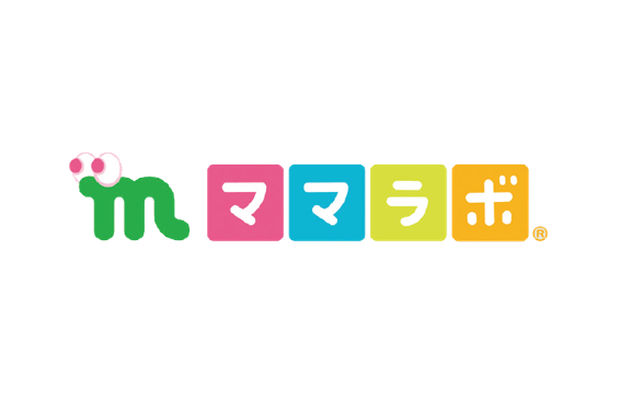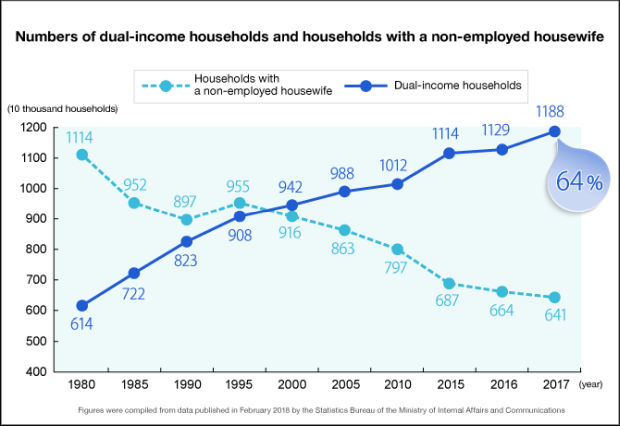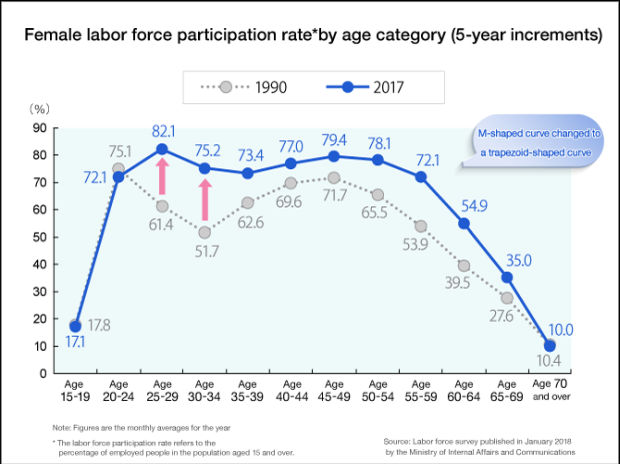
More Married Couples in Japan Are Sharing Household Duties Equally — What Kind of People Are They?

In Japan today, the percentage of households in which both the husband and wife are working now exceeds 60%, which raises questions about how families and the role of mothers are changing. With the increasing number of working women, a debate has emerged regarding how housework and childcare should be shared by spouses. Over the past few years, expressions referring to various arrangements for handling these responsibilities have become topical in Japan, including new words for describing women who take on all of these duties and for families that designate specific chores to each member.
Since setting up the Mama Lab team in 2009 to carry out research on mothers in Japan, Dentsu has been offering practical solutions for family-related issues by uncovering interesting data on mothers, fathers, children and households. In this article, Erika Matsubara, a member of the team, draws from the results of a survey of dual-income married couples to explain how the roles of husbands and wives have recently been changing, and describes the characteristics of husbands and wives who share household duties equally.

Japanese women will play an increasingly larger role in the labor force

According to data published by Japan’s Ministry of Internal Affairs and Communications, the number of dual-income households in Japan has been growing year by year, surpassing the number of households with a non-employed housewife in 2000, and then climbing to 64% in 2017.
In the past, many women in their twenties and thirties left the labor force because of life stage changes, particularly marriage and childbirth. As shown in the graph below, the female labor force participation rate resembled an M-shaped curve in 1990, but later changed to a trapezoid-shaped curve by 2017 due to an increased number of working women between the ages of 20 and 39.

Another factor is worth mentioning. With the goal of facilitating the success of women in the workplace, the Japanese government is aiming to have 30% of all management and leadership positions filled by women by 2020 (according to the website of the Gender Equality Bureau Cabinet Office).
These trends show that Japanese women are not only continuing to work but also seeking to advance their careers, meaning they may have grown more confident compared with previous generations.

How we defined an equal married couple
In recent years, many people in Japan have seen fathers visiting their child’s nursery school and heard stories of male acquaintances that make an active effort to help with housework and childcare after becoming a father. Sharing housework and childcare duties has become topical, but has the situation in the country actually changed? Our team set out to determine whether husbands and wives have taken on new roles, particularly in younger families, and whether housework and childcare duties have been allotted equally by some married couples, which we dubbed “equal married couples.” We began by carrying out a survey of married couples to see how equally they allotted these duties.
Initially, however, it was difficult to define an equal married couple. Which housework and childcare duties should be included among those equally allotted by a husband and wife? Should the definition be solely based on the actual proportions of the allotted housework and childcare responsibilities? Those were some of the questions raised by members of our team.
Eventually, in order to reflect the actual circumstances as best we could, we narrowed down household responsibilities into four categories: cooking, cleaning, laundry, and childcare. For each of these categories, we asked each survey respondent to specify the ratio of work he or she handled relative to his or her spouse. When holding meetings with respondents, we learned that all housework and childcare duties were not allotted equally between mothers and fathers; instead, each spouse was mainly responsible for different categories of household duties. In some cases, for example, cleaning was handled by the father while cooking was done by the mother. Indeed, rules and approaches to these chores differed with each household. Taking all of that into account, we defined an equal married couple as one in which the average ratio of household chores across all four categories performed by the wife and husband was either fifty-fifty, 60% by the wife and 40% by the husband, or, conversely, 40% by the wife and 60% by the husband.
Surprisingly, the survey results indicated that only 5.6% of the survey respondents were equal married couples—a very small minority. In comparison, 22.7% of the respondents said that about 80% of responsibilities were handled by the wife and 20% by the husband (or, conversely, 20% by the wife and 80% by the husband). Couples that said either 90% or all of the duties were handled by the wife (or, in some cases, the husband) accounted for 71.6% of the survey respondents.

What kind of people are equal married couples? Typical examples emerge from our survey
By looking at the results of our survey, we learned various things about equal married couples with children. Firstly, we found that the average age of the mothers and fathers was 34.4 and 34.2 years old, respectively. It is worth mentioning that both men and women of that age in Japan were required to take home economics courses in junior and senior high school. Moreover, the trend of people marrying and having children in their thirties existed at the time when dual-income households overtook single-income households. In addition, during their junior high school to college years, people around that age experienced the launch of Japanese social networking services like i-mode and mixi, and gained digital literacy by using various devices that have since become common in everyday life.
As it turned out, some of the typical mothers and fathers in equal married couples we surveyed appeared to be highly informed on average. Among the mothers, 12.5% said they kept up to date via news websites and social media, compared with just 5.9% of all female respondents, and 22.9% said they would recommend things they like to other people, compared with 14.4% of the entire sample of mothers.
In addition, these typical mothers appeared to be motivated to gain job-related skills. Exactly 50.0% responded that they were committed to their job in addition to their family, compared with 26.8% of all female respondents, and 22.9% expressed a desire to study English, compared with 9.9% of the total.
Turning to the fathers in equal married couples, many indicated a commitment to finding a reasonable balance between work and family life. Compared with 21.3% of all fathers surveyed, 36.7% of them said they would cooperate with their wife to adjust their schedules when a child is ill or another important matter comes up. Similarly, 38.8% said they would not hesitate to leave work early for childcare reasons, compared with 29.3% of the total. Similarly, 38.8% responded that they do not regard time spent with the family as an obligation, compared with 26.0% of all male respondents. This indicates that instead of merely designating their days off as family time, fathers in equal married couples genuinely enjoy being together with their family members.

Erika Matsubara is a marketing planner at Dentsu.
This article was originally published on the Dentsu website on February 21, 2019.
This article was originally published on the Dentsu website on February 21, 2019.













